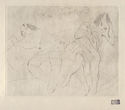
19th, 20th & 21st Century Fine Prints
707-546-7352 · fax 707-546-7924 · web: www.annexgalleries.com · email: artannex@aol.com
Jules Pascin Biography
Jules Pascin
French / American
1885–1930
Biography
Julius Mordecai Pincas, known as Jules Pascin, was born on March 31, 1885, in Vidin, Bulgaria to a Spanish-Sephardic Jewish father and a Serbian-Italian mother, the eighth of eleven children. His family moved to Bucharest in 1892. His early artistic training was in Vienna in 1896 and Munich in 1897. About the same time, he began contributing drawings to Simplicissimus, a satirical magazine published in Munich, which he continued to do until 1929.
In December 1905 Pascin moved to Paris, becoming part of the great migration of artists to that city at the start of the 20th century. At that point he adopted the pseudonym Pascin (an anagram of Pincas) and soon became the symbol of the Montparnasse artist community. Always in his bowler hat, he was a witty presence at Le Dôme café, Le Jockey club, and the others haunts of the area’s bohemian society, and was known for hosting legendary all-night parties. In 1907 Pascin met Hermine Lionette Cartan David, also a painter, and they became lovers. They lived together until Pascin left for America on October 3, 1914, in order to avoid conscription in the Bulgarian Army. He immigrated to New York, where he stayed through 1920 and would later return again in 1927. Hermine David sailed for the United States to join Pascin on October 31, 1914.
Pascin used his time in the United States to travel extensively, especially in the southern states and the Caribbean islands, recording his travels in sketches that were widely acclaimed. Pascin married Hermine David in 1918. In 1920, Pascin was awarded American citizenship with support from Alfred Steiglitz and Maurice Sterne. Pascin taught at the Telfair Academy in Savannah, Georgia, associated with the Telfair Art Museum.
He returned to Paris in October of 1920 where he resumed a relationship with Lucy Vidil Krohg, who had been his lover ten years earlier. She opened a gallery in Paris and featured his work. While his exhibitions were generally very well received, a series of unfavorable reviews in 1930 of his exhibition at the Knoedler Galleries in New York, threw Pascin into a severe depression. After visiting his own prestigious solo exhibition at the Galerie Georges Petit on June 2nd, 1930, Pascin committed suicide on June 5, by slitting his wrists and hanging himself in his studio in Montmartre. On the wall he left a message written in his own blood that said good-bye to his lost love, Lucy Krohg.
On the day of Pascin’s funeral, all the galleries in Paris closed. Thousands of acquaintances from the artistic community along with dozens of waiters and bartenders from the restaurants and saloons he had frequented all dressed in black and walked behind his coffin the three miles to the Cimetière de Saint-Ouen.




